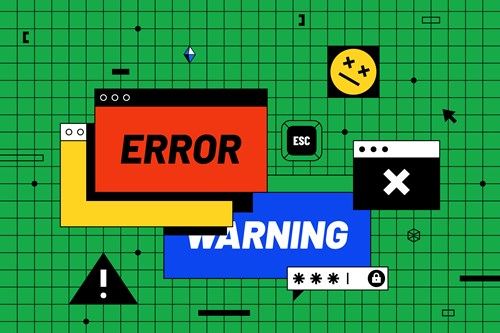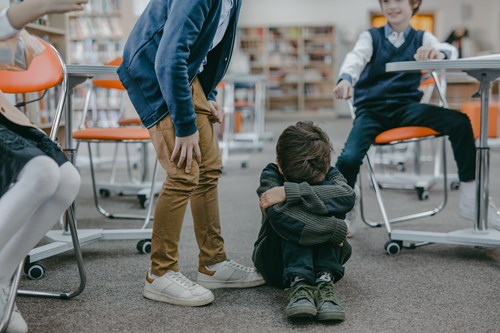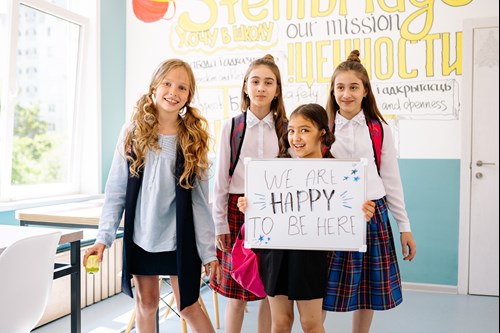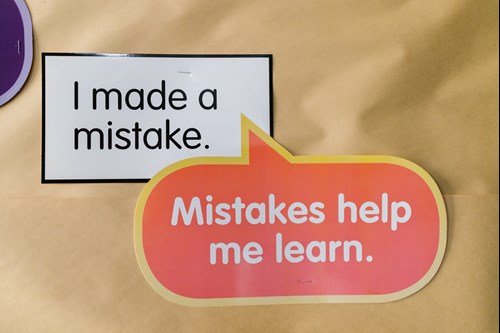Creating a culture of welcoming mistakes
As the new term starts, what kind of learning culture do you want to establish in your classroom? How much thought do you give to it? What impact might improving the learning culture have on the learning outcomes? Read on to discover some practical ways to establish psychological safety in the classroom, and how it encourages learners to try out new language, whilst daring to make mistakes.

With most of us returning to the classroom this month there seems to be no better time to think about what kind of learning culture we want to establish in our classroom. Now, purposefully creating our preferred learning culture requires us to first explore which beliefs guide our approaches to learning, teaching and interactions with our learners.
Looking back
Have you ever deliberately taken the time to think about what beliefs guide you in establishing your classroom culture? I vividly remember the moment that sparked my interest in learning and teaching, it was at secondary school. I had walked into my French class that morning and sat down waiting to see who would be nominated to recite all the vocabulary items we had had to study.
The teacher in question had a habit of keeping us in suspense whilst he would – at a snail’s pace – slowly scroll down the attendance list, carefully announcing, ‘Today’s turn is for …’. You could hear a pin drop. Looking around I noticed that most of us seemed to have shrunk behind our desks. We all had our heads down to make ourselves as small as possible in the hope he wouldn’t nominate us as we all knew that making mistakes resulted in punishment: learning a French poem by heart!

From that day on I started to become more aware of our behaviour as student in various classes and in particular how little response my French teacher got at the end of his lessons when he’d announce, ‘Any questions? Ask them now ... In French!’ No one ever did. We didn’t to risk being told we were bad students because we made a mistake.
What was going on?
I’d summarise the cause of our behaviour in one word: Fear. We were petrified of this teacher. I don’t think I need to tell you that most of us couldn’t wait to drop French as a subject! For those who continued it’s debatable how much French we actually learned from being in that classroom. Being petrified does not facilitate the learning process as we know by now.
Upon reflection the main issue was the classroom culture. Our learning behaviour in this class was purely driven by fear. We completed the required activities not because we enjoyed the role plays – we did it to avoid being singled out and having to perform it in front of the whole class! And why didn’t we ask any questions, even though we had loads to ask? Simply because we did not feel safe or comfortable enough.

Knowing so much more about education psychology now I think the best way to describe this kind of fear-driven learning environment is as one that was lacking any sense of psychological safety. The experience established a very strong belief in me that still underpins everything I do in learning, teaching and training: I don’t want a culture of silence in my classroom, I want to create an emotional safe learning environment for all learners. I want to create a classroom culture that is welcoming of mistakes, where students know I’m there for them so they can feel safe enough to try and go beyond using language they already know. And of course, feel they can ask any questions they have.

It's all about psychological safety
The concept of psychological safety originates in organisation psychology and was first coined by Amy Edmondson who defined it as ‘a belief that one will not be punished or humiliated for speaking up with ideas, questions, concerns or mistakes and that the team is safe for interpersonal risk-taking’ (1999).
You might question how this concept relates to the classroom. Well, if learners are feeling unsafe with their teacher or peers – maybe due to the certain attitudes or comments when mistakes are made or previous learning experiences – the brain interprets the situation as a threat: we feel fear. As a result, our threat system, an emotional regulation system in our brain focused on survival, kicks in (Gilbert, 2009). This can either lead to a freeze response (If I make myself small, they will not see me so I am safe.) or an attempt to avoid the situation (Can I fight it? If not, I run for it and hide.). In other words, if we do not feel psychologically safe, fear can stop learners from actively participating or even worse, from simply trying. To create the conditions for any cognitive development, learning, to happen, first developing a psychologically safe learning environment is essential.

Building a classroom culture that welcomes mistakes
By establishing a classroom culture where students experience psychological safety students know they don’t need to worry about making mistakes and asking questions, which are both crucial elements of the learning journey. Learning within an environment where mistakes are regarded as learning opportunities will increase students’ willingness to try which allow us to further their learning based on students’ emerging needs. When students know making mistakes and asking question are a normal part of the learning process and there is no need for the brain to feel under threat. Win-win right? So where can we start?
Here are some practical steps you can put into action to build a culture of mistakes in your classroom:
- Build a positive climate: As with all learning, the foundation is building developing a good rapport with your learners and encouraging good relationships between learners so they know they can trust you and each other to be supportive and respectful. ‘Psychological safety begins in a climate in which people are comfortable expressing and being themselves’ (Mercer & Gregersen, 2020). At the core of this is really knowing your learners and making every student feel valued and included, so they feel there is a sense of trust and belonging in the classroom. Working in groups can help learners build connections and create a sense of belonging. If you are looking for ideas on how to build rapport and relationships in the classroom, you can find some here: Rethinking teaching and training in times of COVID-19.
- Explore what students believe: Values and beliefs play a huge part in how we behave and how we think about experiences. Such beliefs are often cultural or formed by previous experiences. Investigating what your students think about making mistakes and what they feel about asking ‘silly’ questions will help you understand their current mindset. By acknowledging their perspectives, we can guide learners toward a mindset we believe to be more beneficial – a growth mindset where the belief that mistakes are an invaluable opportunity for further learning and self-development. Give them a sentences starter to complete such as, ‘A good learner is …’. Then, elicit or emphasise that such a learner is not someone who never makes mistakes, which leads us to the next point.
- Clearly communicate expectations: Establish that you welcome mistakes in the classroom. Share one of your own learning experiences to illustrate the point. Communicate your definition of success and, if needed, reframe their view of mistakes. Mistakes in our classroom are not threats but instead fabulous opportunities to thrive. Explain that when students make mistakes you can better see how you can help them develop their language even further. In fact, encourage students to make them! Depending on the age group you can hang up a poster with the words, ‘Mistakes are welcome’ or give each student two popsicle sticks (or another tangible form of reward). Every time they make a mistake, they hand in one stick, they are successful if they have none left at the end of the lesson, and can leave with them both.
- Normalise making mistakes: Model them. Yes, you read that correctly! Occasionally purposefully make a mistake on the board or in your feedback and allow students to correct you. Don’t apologise, instead acknowledge that you made mistake and thank students for noticing and correcting it. Show that making mistakes is okay, it is human and not a big deal. Give students error-correction activities, students check some sentences in pairs and tick the accurate ones and correct the others together. Using error-correction activities does not only show how mistakes can be learning opportunities, but it also provides an opportunity for learners to talk about the language together.

- Be aware of your own communication: Language learning is hard work. At times improvement might be slower that we expect, but language learning takes time so make sure you show empathy for your learners. Research has shown that the language teachers use can directly affect student’s mindset so be mindful and choose your words wisely. When dealing with mistakes, avoid judgemental comments, think about encouraging self- or peer- correction. For example, instead of ‘No, that’s wrong. Try again.’ or ‘You should have used the present perfect!’ try a more exploratory approach, like ‘Can you think of a different tense, we studied it last week, and why that might fit better in this sentence?’ In other words, when praising, praise the effort or the product not the person. And of course, manage your body language and facial expressions as they can convey so much more than words can say!
Final thoughts
I’d be on cloud nine (or was it seven, I’m not sure …) if this blog post convinces even just one teacher to change their beliefs about making mistakes and triggers the reframing of mistakes from being something ‘bad’ to something we should embrace as learning opportunities.
So, if you are intent on creating a culture of mistakes in your classroom, ditch those activities that hand out yellow and red cards to learners for making mistakes (because they undermine any psychological safely and trust in your classroom as you’ve just seen) and instead, try putting some of the ideas I’ve suggested into action to start building a psychological safe environment.
Do let us know how you got on in the comments below or via MET’s social media!
References
Edmondson, A. C. (2020). ‘The role of psychological safety in diversity and inclusion’. Psychology Today. New York: Sussex Publishers, LLC
Edmondson, A.C. (2018). The Fearless Organization: Creating psychological safety for learning, innovation and growth. New York: Wiley
Edmondson, A. C. (1999). ‘Psychological safety and learning behavior in work teams’. Administrative Science Quarterly, 44: 2, 350–383. Thousand Oaks, California: Sage Publications, Inc.
Gilbert, P. (2009). The Compassionate Mind: A new approach to life’s challenges. London: Constable and Robinson Ltd.
Hasper, A. (2021). ‘Rethinking teaching and training in times of COVID-19’. Modern English Teacher, 30: 1.
Mercer, S. & Gregersen, T. (2020). Teacher Wellbeing. Oxford: OUP Oxford.

Comments
Write a Comment
Comment Submitted